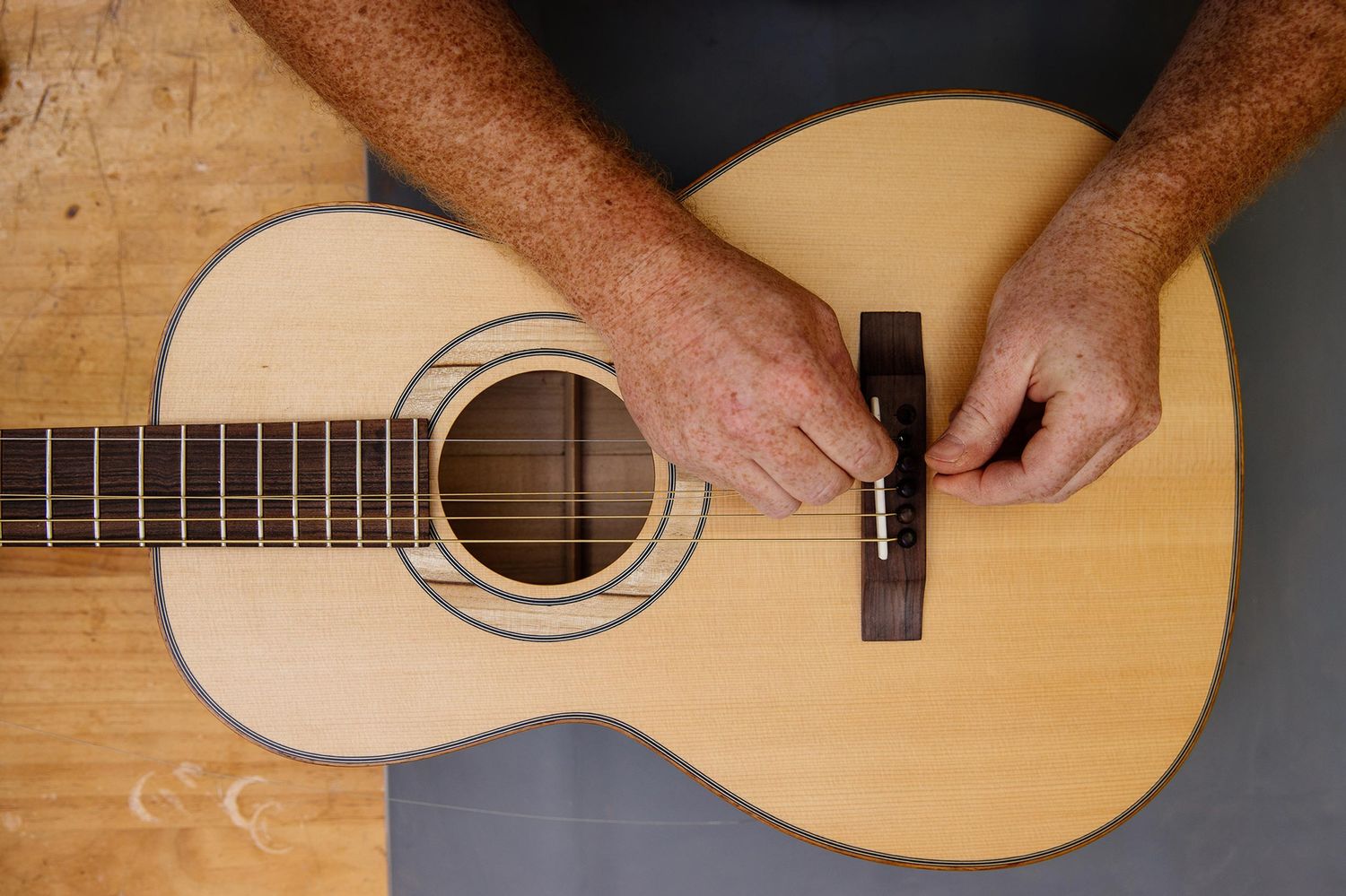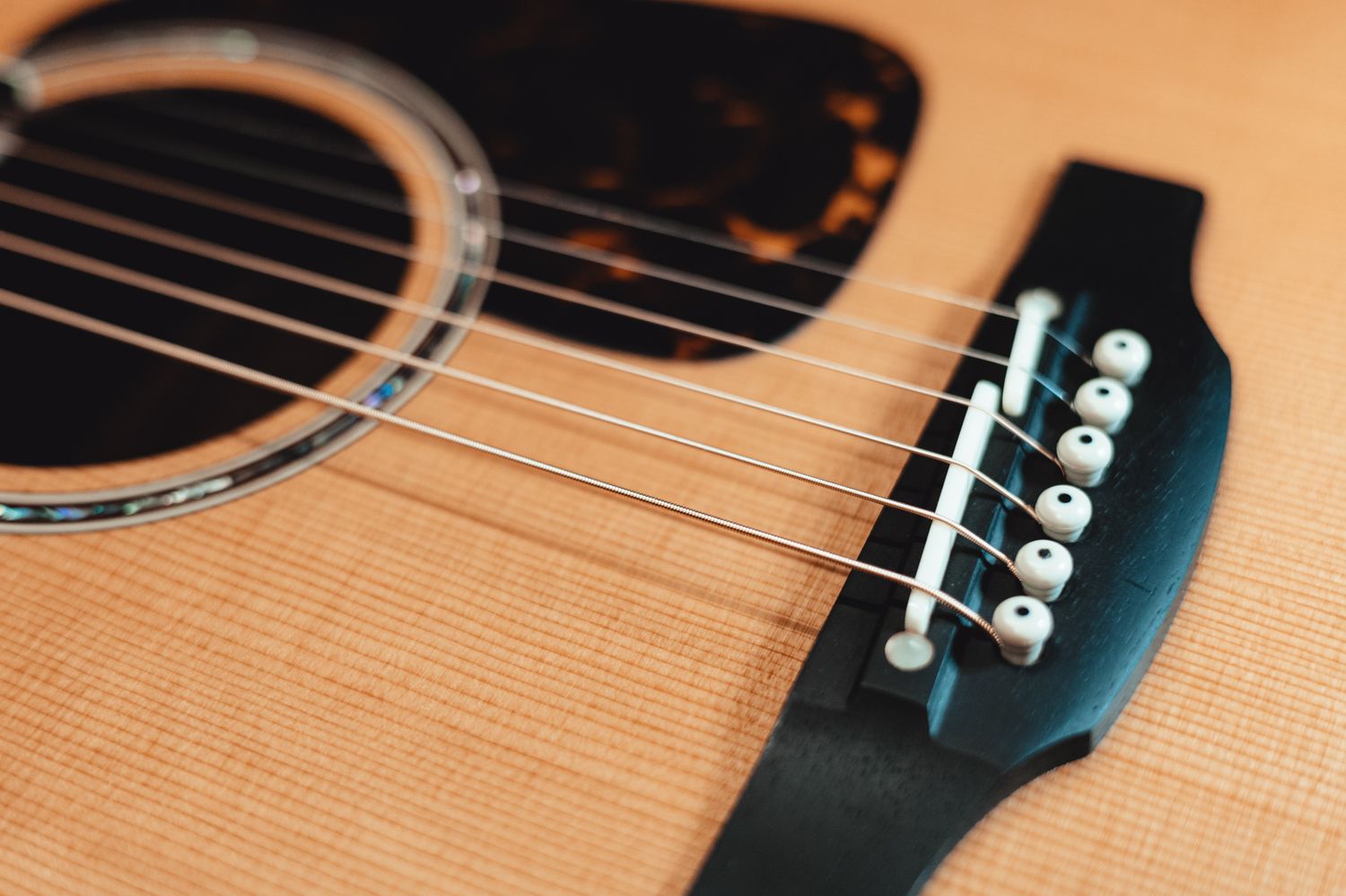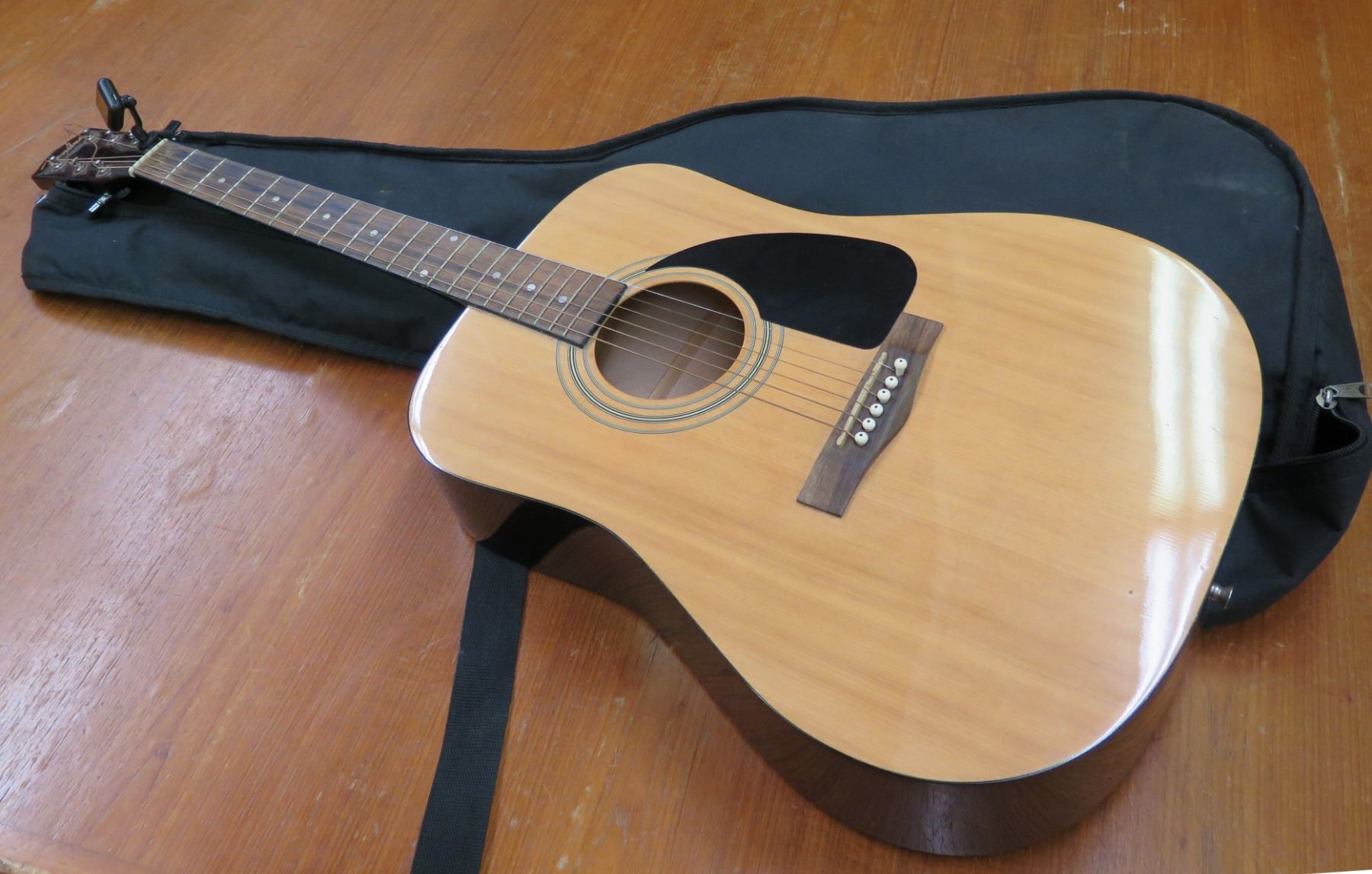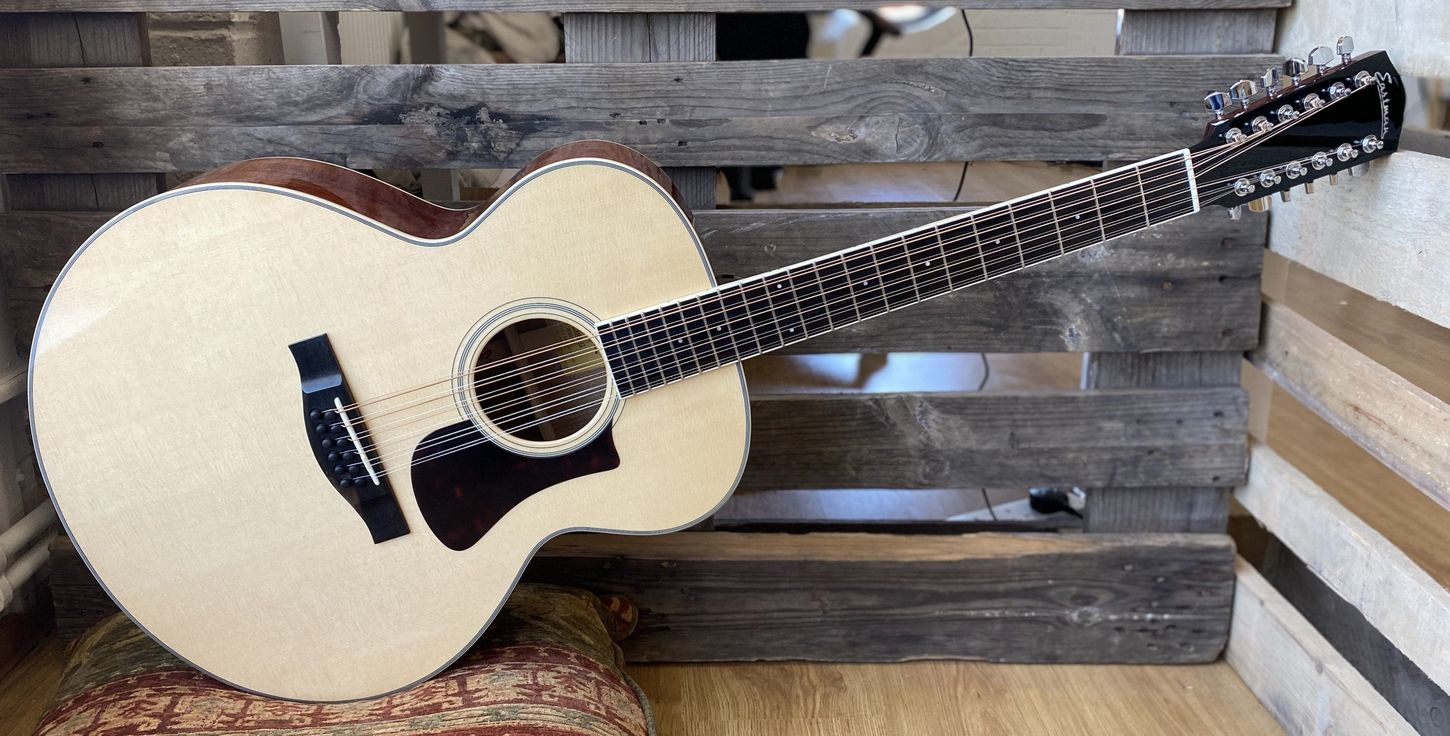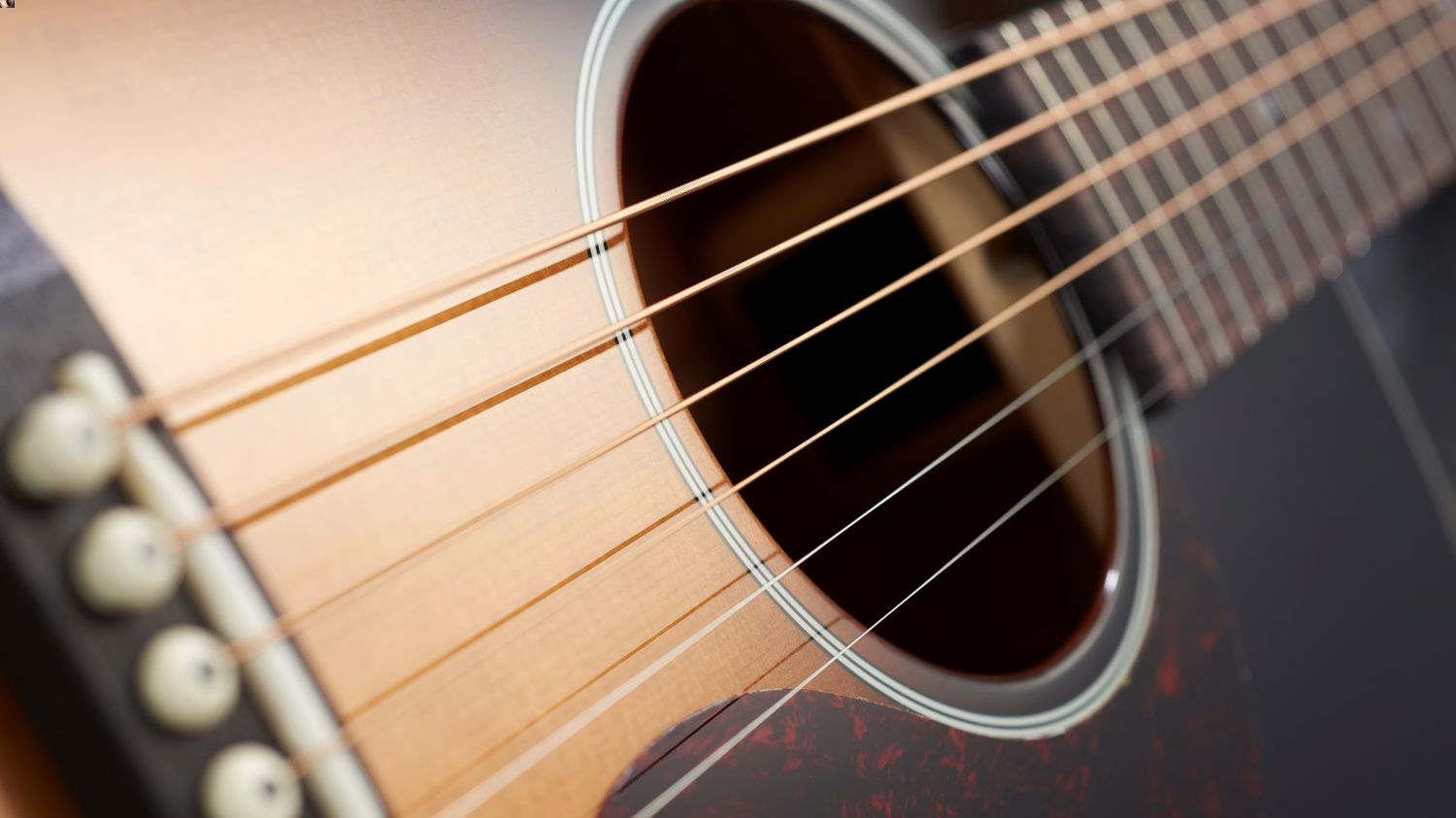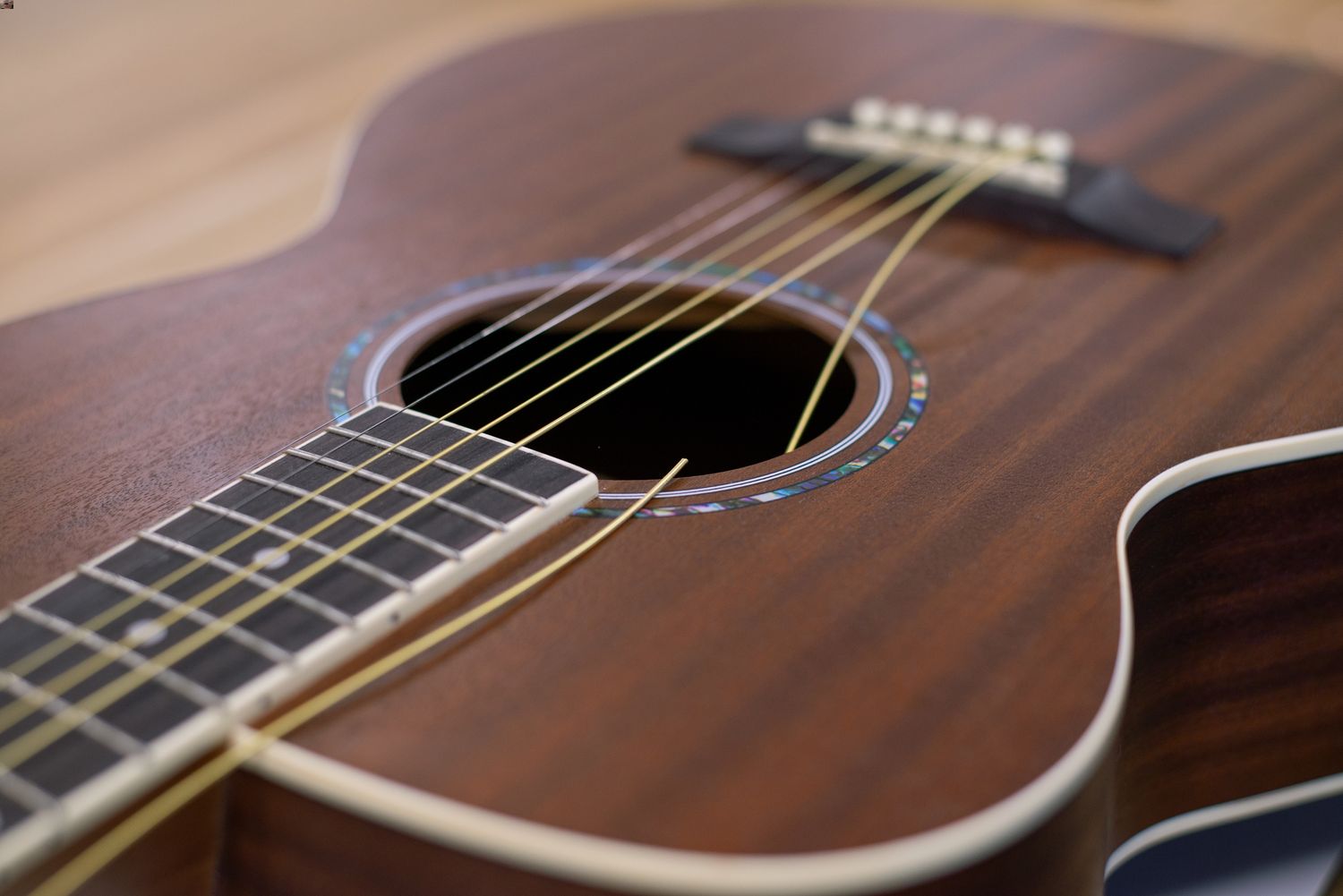Home>Production & Technology>Acoustic>How To String A Nylon Acoustic Guitar
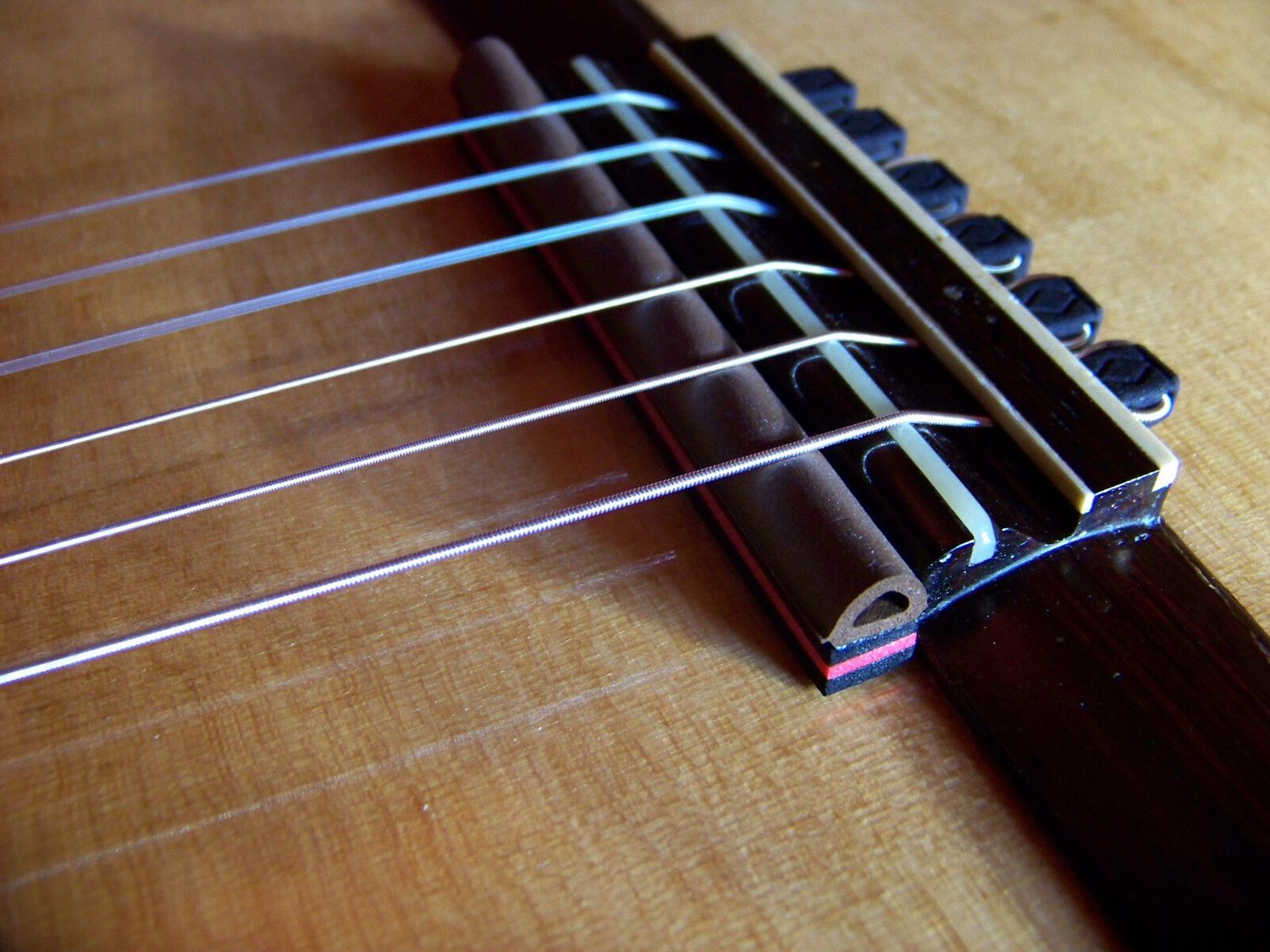

Acoustic
How To String A Nylon Acoustic Guitar
Published: March 11, 2024
Learn how to properly string a nylon acoustic guitar with our step-by-step guide. Keep your instrument sounding its best with our expert tips and techniques.
(Many of the links in this article redirect to a specific reviewed product. Your purchase of these products through affiliate links helps to generate commission for AudioLover.com, at no extra cost. Learn more)
Table of Contents
Introduction
Stringing a nylon acoustic guitar is an essential skill for any guitarist, whether you're a seasoned musician or just starting your musical journey. The process of restringing your guitar not only ensures optimal sound quality but also plays a significant role in maintaining the instrument's overall health and playability. Whether you're drawn to the warm, mellow tones of classical music or the versatility of folk and pop, understanding how to string a nylon acoustic guitar is a fundamental aspect of caring for your instrument.
The process of restringing a nylon acoustic guitar involves several steps, each of which contributes to the overall sound and playability of the instrument. From selecting the right strings to properly attaching and tuning them, every detail matters in achieving the desired sound and feel. Additionally, knowing how to stretch and maintain the strings can prolong their lifespan and ensure consistent performance.
In this comprehensive guide, we will walk you through the step-by-step process of stringing a nylon acoustic guitar, providing valuable insights and tips to help you achieve optimal results. Whether you're a solo performer, a member of a band, or simply enjoy strumming your favorite tunes at home, mastering the art of stringing your guitar will undoubtedly enhance your musical experience. So, let's dive into the world of nylon strings and discover the rewarding process of maintaining and optimizing your acoustic guitar's performance.
Choosing the Right Nylon Strings
When it comes to selecting the right nylon strings for your acoustic guitar, it's essential to consider various factors that can significantly impact your playing experience and the overall sound of the instrument. Nylon strings are available in different materials, tensions, and gauges, each offering unique characteristics that cater to different playing styles and preferences.
Material
Nylon strings are commonly made from two primary materials: nylon and fluorocarbon. Traditional nylon strings are known for their warm and mellow tones, making them ideal for classical and fingerstyle guitar playing. On the other hand, fluorocarbon strings, also referred to as carbon strings, offer a brighter and more articulate sound, making them suitable for a wide range of musical genres, including folk, pop, and jazz.
Tension
Nylon strings come in various tension levels, such as low, normal, and high tension. The tension of the strings directly affects the feel and playability of the guitar. Low-tension strings are more flexible and easier to press down, making them suitable for beginners and players who prefer a lighter touch. Normal tension strings strike a balance between flexibility and stability, offering a versatile option for different playing styles. High-tension strings provide increased stability and projection, making them ideal for players who require a more robust sound and greater resistance to bending.
Gauge
The gauge of nylon strings refers to the thickness of the strings, typically categorized as light, medium, or heavy. Lighter gauge strings offer a more delicate and responsive feel, making them well-suited for intricate fingerpicking and subtle nuances in playing. Medium gauge strings provide a balanced response and versatility, catering to a wide range of musical styles. Heavy gauge strings deliver a robust and powerful sound, making them suitable for players who require strong projection and durability.
When choosing the right nylon strings for your acoustic guitar, it's crucial to consider your playing style, musical preferences, and the specific sound characteristics you aim to achieve. By carefully evaluating the material, tension, and gauge of the strings, you can tailor your guitar's sound and playability to align with your musical expression and performance needs.
Removing the Old Strings
Before embarking on the process of attaching new strings to your nylon acoustic guitar, it is crucial to properly remove the old strings. This step is essential for maintaining the integrity of the instrument and preparing it for the installation of fresh, vibrant strings.
-
Loosening the Strings: Begin by turning the tuning pegs to loosen the tension of the old strings. This can be done by turning the pegs in a counterclockwise direction, gradually reducing the tension until the strings become slack.
-
Removing the Bridge Pins: For guitars with bridge pins securing the strings, carefully use a bridge pin puller or a suitable tool to extract the pins from the bridge. Gently wiggle the pins while pulling them out to avoid any damage to the bridge or the surrounding area.
-
Unwinding the Strings: Once the bridge pins are removed, unwind the strings from the tuning pegs at the headstock. Slowly unwind each string, taking care to avoid any sudden release of tension that could cause damage to the guitar or result in injury.
-
Discarding the Old Strings: After removing all the strings, discard them responsibly. Proper disposal of old strings is important for environmental sustainability. Many music stores and recycling centers accept old strings for recycling, so consider exploring these options to minimize waste.
-
Cleaning the Guitar: With the old strings removed, take the opportunity to clean the fretboard, bridge, and other areas of the guitar that may have accumulated dirt and debris. A soft, dry cloth can be used to gently wipe down these areas, ensuring that the guitar is clean and ready for the new strings.
By meticulously following these steps, you can effectively remove the old strings from your nylon acoustic guitar, setting the stage for the next phase of the restringing process. Properly removing the old strings not only facilitates the installation of new strings but also allows for the inspection and maintenance of the guitar's components, contributing to its overall longevity and performance.
Attaching the New Strings
Attaching new strings to your nylon acoustic guitar is a pivotal step that directly influences the instrument's sound quality, playability, and overall performance. Properly securing the new strings ensures stability, intonation, and resonance, allowing you to fully experience the unique tonal characteristics of your guitar. Here's a detailed guide on how to attach the new strings with precision and care:
1. Inserting the Strings
Begin by inserting the end of the first string into the corresponding bridge hole, ensuring that it sits securely in place. For guitars with bridge pins, insert the string through the bridge hole and align it with the appropriate slot on the bridge saddle. The string should extend beyond the bridge, allowing ample length for winding around the tuning peg.
2. Securing the Strings at the Bridge
For guitars with bridge pins, carefully align the holes in the bridge with the corresponding slots on the saddle, ensuring that the strings are correctly positioned. Gently press the bridge pins into place, firmly securing the strings while maintaining proper alignment and tension.
3. Winding the Strings at the Headstock
Moving to the headstock, guide the inserted string to the corresponding tuning peg. Begin winding the string in a clockwise direction around the peg, ensuring that each turn is neat and orderly. Maintain slight tension on the string as you wind it, allowing for a consistent and secure grip around the peg.
4. Securing and Tuning
Once the string is adequately wound around the tuning peg, ensure that it sits snugly in the nut and the bridge saddle. Gradually tighten the string by turning the tuning peg, taking care to maintain even tension and proper winding. As the string approaches the desired pitch, use a tuner to accurately tune it to the correct note.
5. Repeating the Process
Repeat the above steps for the remaining strings, ensuring that each string is inserted, secured, and tuned with precision. Pay close attention to the winding technique, maintaining uniformity and tension across all strings to achieve balanced intonation and stable tuning.
By meticulously following these steps, you can effectively attach the new strings to your nylon acoustic guitar, setting the stage for optimal sound quality, resonance, and playability. The process of securing the new strings is a crucial aspect of maintaining your guitar's performance and ensuring a rewarding playing experience. With the new strings in place, your guitar is poised to deliver rich, vibrant tones and responsive playability, allowing you to fully express your musical creativity and passion.
Tuning the Guitar
Tuning a nylon acoustic guitar is a fundamental step that directly impacts the instrument's sound quality, playability, and overall musical expression. Achieving precise tuning ensures that each string resonates at the correct pitch, allowing for harmonious chords, melodic passages, and a balanced tonal spectrum. Whether you're a seasoned guitarist or a novice player, mastering the art of tuning your guitar is essential for delivering captivating performances and enjoying a fulfilling musical experience.
Importance of Accurate Tuning
Accurate tuning is paramount in ensuring that your guitar produces the intended notes and chords with clarity and resonance. A well-tuned guitar not only enhances the musicality of your playing but also facilitates seamless collaboration with other musicians and accompaniment to various musical genres. Additionally, precise tuning contributes to the longevity of the strings and the overall health of the instrument, minimizing undue stress on the neck, bridge, and other components.
Tuning Methods
There are several methods for tuning a nylon acoustic guitar, with the most common being standard tuning, where the strings are tuned to the notes E4, B3, G3, D3, A2, and E2 from the lowest to the highest string. Tuning can be accomplished using a variety of tools, including electronic tuners, pitch pipes, tuning forks, or even tuning apps available on smartphones and tablets. Each method offers its unique advantages, catering to different preferences and environments.
Tuning Process
Begin the tuning process by ensuring that your guitar is in a stable and comfortable playing position. If using an electronic tuner, attach it to the headstock or place it within view of the guitar's soundhole. Pluck each string individually and observe the tuner's display to gauge whether the string is in tune. If the pitch is sharp or flat, adjust the tuning peg accordingly, gradually bringing the string to the correct pitch.
As you tune each string, pay attention to the interaction between the strings and the overall balance of the instrument's sound. Strive for uniform tension and resonance across all strings, ensuring that the guitar produces a cohesive and harmonious blend of notes. Once all strings are tuned to the desired pitches, play a few chords and scales to confirm the overall tuning accuracy and make any necessary adjustments.
Fine-Tuning and Intonation
In addition to standard tuning, it's essential to fine-tune the guitar by checking the harmony of intervals, such as octaves and fifths, to ensure precise intonation. This involves assessing the relationship between fretted notes and open strings, making subtle adjustments to the bridge saddle if necessary. Fine-tuning the intonation contributes to the guitar's overall tonal accuracy and ensures that chords and melodies resonate with clarity and depth.
By meticulously following the tuning process and paying attention to fine-tuning and intonation, you can achieve optimal sound quality and playability on your nylon acoustic guitar. A well-tuned guitar not only enhances your musical performance but also fosters a deeper connection with your instrument, allowing you to explore a diverse range of musical styles and express your creativity with confidence and precision.
Stretching the Strings
Stretching the strings of a nylon acoustic guitar is a crucial step in the restringing process that significantly impacts the instrument's stability, tuning retention, and overall playability. When new strings are installed, they possess inherent elasticity that can cause them to stretch and settle over time. Stretching the strings helps expedite this natural settling process, minimizing the need for frequent retuning and ensuring consistent pitch stability during playing sessions.
To stretch the strings, begin by gently tugging each string along its length, applying gradual and even pressure to encourage the stretching process. It's important to exercise caution and avoid excessive force, as nylon strings are more delicate compared to their steel counterparts. By gently pulling and releasing each string, you allow the material to adjust and settle, reducing the likelihood of sudden pitch shifts and tuning instability during performance.
As you stretch the strings, pay close attention to the tension and feel of each string, noting any initial changes in pitch and elasticity. Repeat the stretching process for each string, ensuring that the entire set undergoes the necessary adjustments for optimal performance. Additionally, playing the guitar and engaging in gentle bending and vibrato techniques can further aid in the stretching process, allowing the strings to acclimate to the tension and movement associated with regular playing.
Stretching the strings is a proactive measure that contributes to the overall stability and longevity of the restringing process. By allowing the strings to settle and adapt to the tension of the guitar, you can minimize the occurrence of tuning fluctuations and ensure that the instrument maintains consistent pitch and resonance. This attention to detail not only enhances the immediate playability of the guitar but also promotes the long-term durability and performance of the strings, allowing you to fully immerse yourself in the musical experience without the distraction of frequent retuning.
Incorporating the stretching process into your restringing routine demonstrates a commitment to maintaining the optimal performance of your nylon acoustic guitar. By allowing the strings to acclimate and settle, you can enjoy extended playing sessions with confidence, knowing that your guitar will deliver reliable and consistent tonal quality, allowing your musical expression to shine through with clarity and precision.
Final Adjustments and Maintenance Tips
After completing the restringing process and ensuring that the new strings are properly attached, tuned, and stretched, it's essential to perform final adjustments and implement maintenance practices to optimize the performance and longevity of your nylon acoustic guitar. These adjustments and tips encompass a range of considerations, from fine-tuning the action and intonation to safeguarding the instrument against environmental factors and wear. By incorporating these final adjustments and maintenance tips into your routine, you can elevate your playing experience and preserve the integrity of your guitar for years to come.
Fine-Tuning the Action and Intonation
Fine-tuning the action, which refers to the height of the strings above the fretboard, can significantly impact the playability and comfort of your guitar. Adjusting the action to suit your playing style and preferences ensures optimal fretting and strumming dynamics, allowing for effortless chord transitions and expressive playing. Additionally, assessing and adjusting the intonation, which pertains to the accuracy of the guitar's notes across the fretboard, contributes to balanced tonal resonance and precise pitch accuracy. By fine-tuning the action and intonation, you can tailor your guitar to deliver a responsive and harmonious playing experience.
Cleaning and Conditioning
Regular cleaning and conditioning of your guitar's body, fretboard, and strings are essential for preserving its aesthetic appeal and structural integrity. Using a soft, lint-free cloth, gently wipe down the guitar's body to remove dust, fingerprints, and smudges, maintaining its luster and finish. When cleaning the fretboard, consider using a specialized fretboard conditioner to nourish and protect the wood, preventing it from drying out and developing cracks. Additionally, wiping down the strings after each playing session can help minimize the accumulation of dirt and oils, prolonging their lifespan and preserving their tonal clarity.
Humidity and Temperature Control
Maintaining an optimal environment for your guitar is crucial in safeguarding it against the adverse effects of humidity and temperature fluctuations. Consider storing your guitar in a protective case or a designated area with stable humidity levels, ideally between 45% and 55%, to prevent warping, cracking, or swelling of the wood. Using a hygrometer in the guitar's storage space can help monitor humidity levels, allowing you to take proactive measures to mitigate potential damage. Furthermore, avoiding extreme temperature changes and prolonged exposure to direct sunlight can help preserve the structural integrity and tonal characteristics of your guitar.
Regular Inspections and Professional Maintenance
Periodically inspecting your guitar for signs of wear, such as fret wear, loose hardware, or structural issues, can help identify potential concerns early on, allowing for timely repairs and maintenance. Additionally, considering professional maintenance services, such as fret leveling, truss rod adjustments, and setup optimizations, can further enhance the playability and performance of your guitar. Consulting a qualified luthier or guitar technician for periodic assessments and adjustments can ensure that your instrument remains in optimal condition, allowing you to fully enjoy its musical potential.
By incorporating these final adjustments and maintenance tips into your guitar care routine, you can uphold the quality, playability, and longevity of your nylon acoustic guitar. Embracing a proactive approach to maintenance and fine-tuning not only enhances your playing experience but also fosters a deeper connection with your instrument, allowing you to explore a diverse range of musical styles and express your creativity with confidence and precision.

